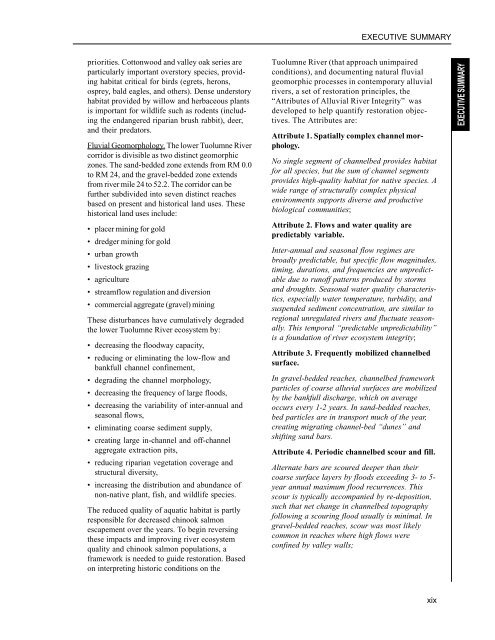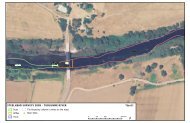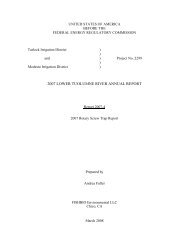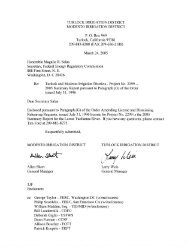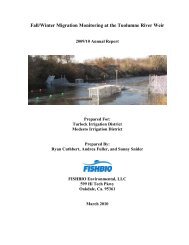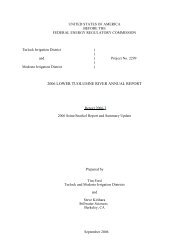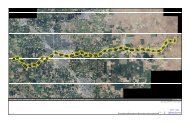Tuolumne River Report - U.S. Fish and Wildlife Service
Tuolumne River Report - U.S. Fish and Wildlife Service
Tuolumne River Report - U.S. Fish and Wildlife Service
You also want an ePaper? Increase the reach of your titles
YUMPU automatically turns print PDFs into web optimized ePapers that Google loves.
EXECUTIVE SUMMARYpriorities. Cottonwood <strong>and</strong> valley oak series areparticularly important overstory species, providinghabitat critical for birds (egrets, herons,osprey, bald eagles, <strong>and</strong> others). Dense understoryhabitat provided by willow <strong>and</strong> herbaceous plantsis important for wildlife such as rodents (includingthe endangered riparian brush rabbit), deer,<strong>and</strong> their predators.Fluvial Geomorphology. The lower <strong>Tuolumne</strong> <strong>River</strong>corridor is divisible as two distinct geomorphiczones. The s<strong>and</strong>-bedded zone extends from RM 0.0to RM 24, <strong>and</strong> the gravel-bedded zone extendsfrom river mile 24 to 52.2. The corridor can befurther subdivided into seven distinct reachesbased on present <strong>and</strong> historical l<strong>and</strong> uses. Thesehistorical l<strong>and</strong> uses include:• placer mining for gold• dredger mining for gold• urban growth• livestock grazing• agriculture• streamflow regulation <strong>and</strong> diversion• commercial aggregate (gravel) miningThese disturbances have cumulatively degradedthe lower <strong>Tuolumne</strong> <strong>River</strong> ecosystem by:• decreasing the floodway capacity,• reducing or eliminating the low-flow <strong>and</strong>bankfull channel confinement,• degrading the channel morphology,• decreasing the frequency of large floods,• decreasing the variability of inter-annual <strong>and</strong>seasonal flows,• eliminating coarse sediment supply,• creating large in-channel <strong>and</strong> off-channelaggregate extraction pits,• reducing riparian vegetation coverage <strong>and</strong>structural diversity,• increasing the distribution <strong>and</strong> abundance ofnon-native plant, fish, <strong>and</strong> wildlife species.The reduced quality of aquatic habitat is partlyresponsible for decreased chinook salmonescapement over the years. To begin reversingthese impacts <strong>and</strong> improving river ecosystemquality <strong>and</strong> chinook salmon populations, aframework is needed to guide restoration. Basedon interpreting historic conditions on the<strong>Tuolumne</strong> <strong>River</strong> (that approach unimpairedconditions), <strong>and</strong> documenting natural fluvialgeomorphic processes in contemporary alluvialrivers, a set of restoration principles, the“Attributes of Alluvial <strong>River</strong> Integrity” wasdeveloped to help quantify restoration objectives.The Attributes are:Attribute 1. Spatially complex channel morphology.No single segment of channelbed provides habitatfor all species, but the sum of channel segmentsprovides high-quality habitat for native species. Awide range of structurally complex physicalenvironments supports diverse <strong>and</strong> productivebiological communities;Attribute 2. Flows <strong>and</strong> water quality arepredictably variable.Inter-annual <strong>and</strong> seasonal flow regimes arebroadly predictable, but specific flow magnitudes,timing, durations, <strong>and</strong> frequencies are unpredictabledue to runoff patterns produced by storms<strong>and</strong> droughts. Seasonal water quality characteristics,especially water temperature, turbidity, <strong>and</strong>suspended sediment concentration, are similar toregional unregulated rivers <strong>and</strong> fluctuate seasonally.This temporal “predictable unpredictability”is a foundation of river ecosystem integrity;Attribute 3. Frequently mobilized channelbedsurface.In gravel-bedded reaches, channelbed frameworkparticles of coarse alluvial surfaces are mobilizedby the bankfull discharge, which on averageoccurs every 1-2 years. In s<strong>and</strong>-bedded reaches,bed particles are in transport much of the year,creating migrating channel-bed “dunes” <strong>and</strong>shifting s<strong>and</strong> bars.Attribute 4. Periodic channelbed scour <strong>and</strong> fill.Alternate bars are scoured deeper than theircoarse surface layers by floods exceeding 3- to 5-year annual maximum flood recurrences. Thisscour is typically accompanied by re-deposition,such that net change in channelbed topographyfollowing a scouring flood usually is minimal. Ingravel-bedded reaches, scour was most likelycommon in reaches where high flows wereconfined by valley walls;EXECUTIVE SUMMARYxix


